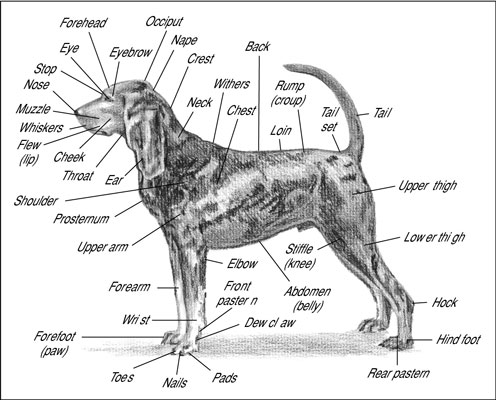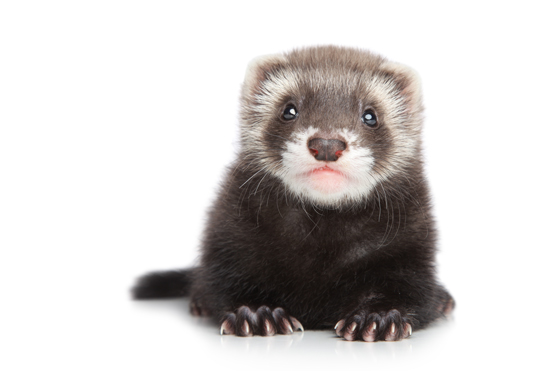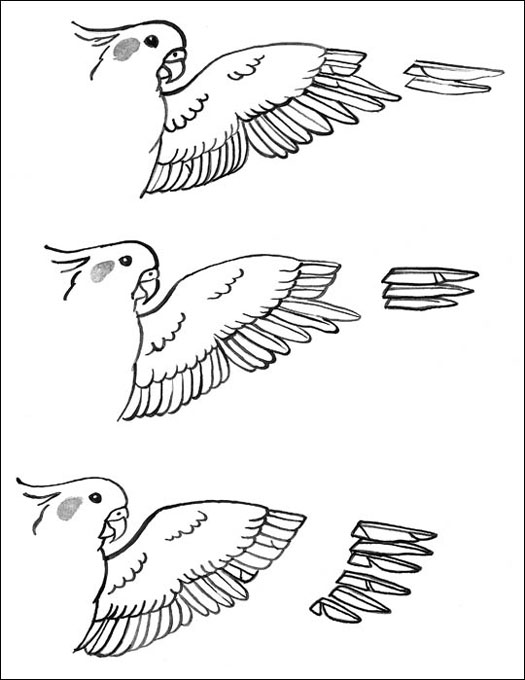約克夏犬:AKC 品種標準
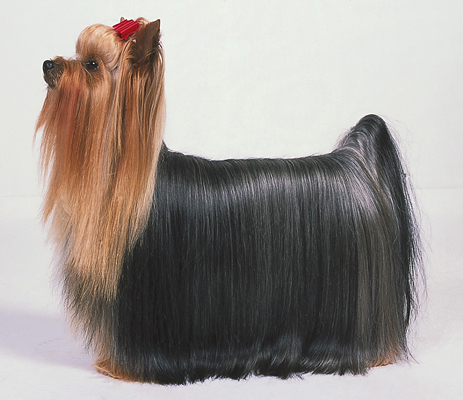
深入了解約克夏犬AKC官方品種標準,包括體型、毛色、外表特徵和展示要求。專業解析幫助您全面認識這個可愛的玩具犬品種。
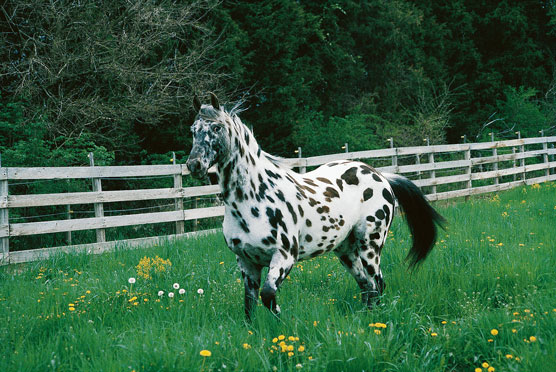
阿帕盧薩
攝影:Gemma Giannini
阿帕盧薩馬首先由愛達荷州北部的內茲珀斯印第安人在 1700 年代和 1800 年代飼養。當內茲珀斯人被迫進入保留地時,阿帕盧薩人品種幾乎滅絕。然而,在 1930 年代,一群有關的騎手聚集在一起,開始註冊以拯救該品種。從那時起,阿帕盧薩馬變得相當受歡迎。
阿帕盧薩馬最顯著的特徵是它的斑點皮毛,特別是帶有黑斑的白色臀部,這是該品種的特徵。也就是說,阿帕盧薩馬有幾種不同的模式,包括:
其他身體特徵包括白色鞏膜——瞳孔周圍的組織,使眼睛看起來幾乎像人類一樣,有條紋的蹄子和斑駁的皮膚。一些阿帕盧薩馬也有細長的鬃毛和尾巴。阿帕盧薩馬的高度範圍是 14.3 到 16 手。
阿帕盧薩馬以其安靜和樂於助人的氣質而聞名。他們在西部賽事、為期三天的三項賽和越野賽中表現出色,並以運動能力和多才多藝而聞名。阿帕盧薩馬是優秀而多彩的伙伴。
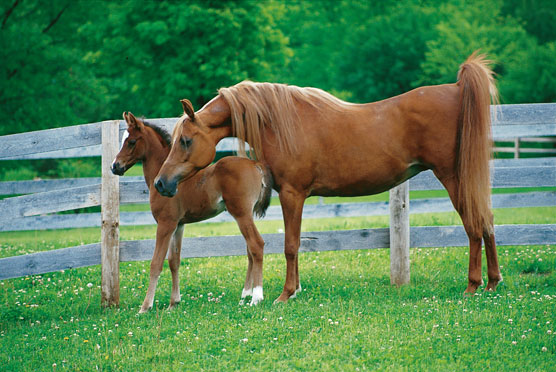
阿拉伯
攝影:Gemma Giannini
阿拉伯馬是現存最古老的馬種之一。數百年前在中東發展起來,許多專家認為阿拉伯馬是現存最好、最純正的馬種之一。阿拉伯馬也是最有影響力的:縱觀馬的歷史,人類一直使用阿拉伯馬來提高其他品種的質量。半阿拉伯品種的一些例子是盎格魯阿拉伯(半純種,半阿拉伯),誇拉(半夸特馬,半阿拉伯),摩拉(半摩根,半阿拉伯)和阿拉阿帕盧薩(半阿帕盧薩,半阿拉伯)。這些交配的目的是創造出具有阿拉伯品種的精緻和另一個品種的特徵的半阿拉伯人。
阿拉伯馬以其優雅優雅的美麗而聞名。阿拉伯人有小腦袋,凹面(或碟形)臉,向內彎曲的小耳朵,以及長而拱形的脖子。大多數阿拉伯馬只有五塊脊椎,而大多數其他品種的馬通常有六塊脊椎。少一根椎骨使阿拉伯人的背部比許多其他品種短。(具有阿拉伯血統的馬可以有五塊或六塊椎骨,具體取決於馬。)
阿拉伯馬是小型馬,高度很少超過 15 手。您可以找到許多不同的顏色,尤其是灰色、栗色、海灣色和黑色。阿拉伯馬是友好和好奇的馬,但它們也可以是意氣風發的。他們在耐力比賽中表現特別出色,並在西部、狩獵席、三項賽、盛裝舞步和馬鞍座班中展示。半阿拉伯人通常會非常享受並展示馬匹。
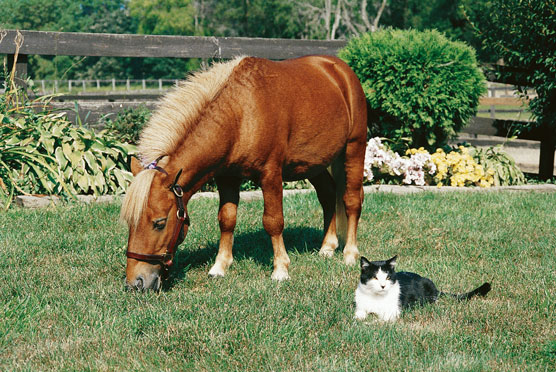
微型馬
攝影:Gemma Giannini
微型馬是馬界的小矮人(比小馬還小),在可愛類別中排名第一。它們在美國越來越受歡迎,儘管它們太小而不能騎。微型馬在一個小包裝中具有普通馬的所有生理和心理特徵。
微型馬是 1800 年代在美國開發的,用於將推車拉入和拉出煤礦。這項工作需要一匹小馬,因為礦山隧道很少容納正常大小的馬。
今天的微型馬有 6 到 7 手高,主要作為寵物飼養。小孩子可以騎微型馬,但 4 歲以上的人可能太大而不能騎微型馬。
儘管它們的體型很小,但微型馬可以輕鬆地用輕型推車拉動一個成年的人。許多微型馬用於娛樂駕駛,您可以在特殊的微型馬錶演中看到它們在比賽中拉著燈光。他們還出現在露背班和其他特殊活動中。
微型馬
攝影:Gemma Giannini
微型馬是馬界的小矮人(比小馬還小),在可愛類別中排名第一。它們在美國越來越受歡迎,儘管它們太小而不能騎。微型馬在一個小包裝中具有普通馬的所有生理和心理特徵。
微型馬是 1800 年代在美國開發的,用於將推車拉入和拉出煤礦。這項工作需要一匹小馬,因為礦山隧道很少容納正常大小的馬。
今天的微型馬有 6 到 7 手高,主要作為寵物飼養。小孩子可以騎微型馬,但 4 歲以上的人可能太大而不能騎微型馬。
儘管它們的體型很小,但微型馬可以輕鬆地用輕型推車拉動一個成年的人。許多微型馬用於娛樂駕駛,您可以在特殊的微型馬錶演中看到它們在比賽中拉著燈光。他們還出現在露背班和其他特殊活動中。
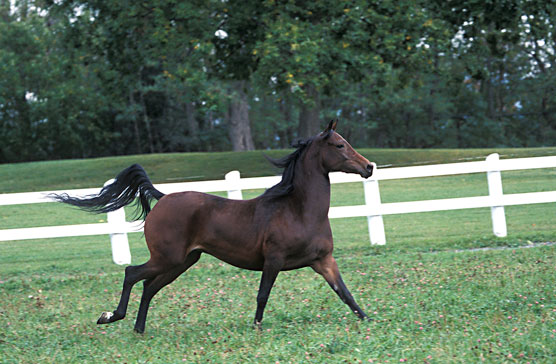
摩根
攝影:Sharon P. Fibelkorn
摩根馬是典型的美國品種,於 1700 年代在佛蒙特州由一匹名叫賈斯汀摩根的小種馬發展而來。以擁有他的人的名字命名,賈斯汀摩根因其驚人的力量和願意的性格而聲名鵲起。摩根品種是通過向賈斯汀摩根繁殖各種不同的母馬而發展起來的。這些母馬產生的小馬駒看起來幾乎完全像賈斯汀摩根,因此該品種誕生了。
今天的摩根擁有小巧優雅的頭部和強壯、高度拱起的脖子。就像他們的創始父親一樣,摩根馬往往是較小的馬,高度很少超過 15.2 手。他們通常出現在海灣、黑色和栗色中,就像他們的始祖一樣,摩根渴望取悅並願意做任何要求他們做的事情。
大多數摩根騎馬只是為了消遣和在小道上騎行,儘管有很多人是在馬鞍座、西式和狩獵座級別上展示的。該品種作為輕型馬車也很受歡迎。
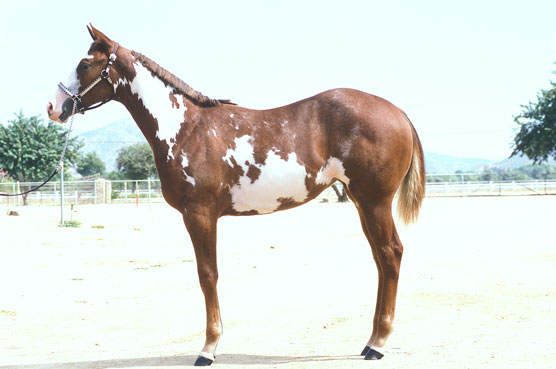
油漆馬
攝影:Sharon P. Fibelkorn
The Paint Horse used to be considered an anomaly — a colorful but unwanted result of many Quarter Horse-to-Quarter Horse breedings. (See the following section for more about Quarter Horses.) Rejected by the Quarter Horse registry because of their coat markings, these patterned horses had no official recognition in the horse world. However, in the early 1960s, a group of horse lovers who appreciated the Paint for its unusual appearance created a registry for the breed that helped it survive and grow.
Paint Horse coats come in a variety of different patterns, most of which fall under the headings:
The breed’s conformation, or the way its horses are put together, is identical to that of the Quarter Horse, with a height range of 15 to 16 hands. Its temperament is much like that of the Quarter Horse too — mellow, easygoing, and eager to please.
The Paint Horse has become wildly popular during the last two decades and can be readily seen in stables and show arenas throughout the country. Most Paint Horses are shown in western classes, although an occasional Paint is seen in dressage, hunt-seat, and other English events. Paints also make excellent companions and trail horses.
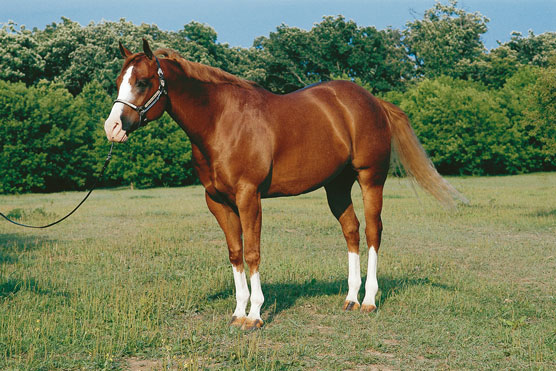
Quarter Horse
Photo by: Gemma Giannini
In the 1600s, American colonists bred horses kept by the Chickasaw Indian nation to horses they had imported from England. The result was the beginnings of the American Quarter Horse, a breed that later developed to its present state in the American West. Used to herd cattle and carry cowboys across the arid desert in the 1800s, the Quarter Horse has a rich and glamorous history. The breed earned its name as a result of its ability to run a quarter of a mile distance faster than any other breed, a feat it still accomplishes today.
The Quarter Horse is a sturdy horse with a small head and muscular neck. The breed’s hindquarters are powerful, and its legs are straight and solid. Quarter Horses come in a number of different colors, including sorrel, chestnut, bay, black, dun, grulla, palomino, roan, and gray (see the color section for photos showing various horse colors). They have a big height range, standing anywhere from 14.3 to 16 hands tall.
One of the Quarter Horse’s most outstanding features is its disposition. This quiet temperament is a big reason behind the Quarter Horse’s huge popularity. Well-known for its steady, easygoing personality, the Quarter Horse makes a good mount for beginning riders who need a quiet and forgiving horse to help them learn.
In the show ring, Quarter Horses prevail in western events; you see them most often in cattle-working competitions, western-pleasure classes, and gymkhana events. The Quarter Horse is the most popular breed of horse in the world, and numbers in the millions.
Quarter Horse
Photo by: Gemma Giannini
In the 1600s, American colonists bred horses kept by the Chickasaw Indian nation to horses they had imported from England. The result was the beginnings of the American Quarter Horse, a breed that later developed to its present state in the American West. Used to herd cattle and carry cowboys across the arid desert in the 1800s, the Quarter Horse has a rich and glamorous history. The breed earned its name as a result of its ability to run a quarter of a mile distance faster than any other breed, a feat it still accomplishes today.
The Quarter Horse is a sturdy horse with a small head and muscular neck. The breed’s hindquarters are powerful, and its legs are straight and solid. Quarter Horses come in a number of different colors, including sorrel, chestnut, bay, black, dun, grulla, palomino, roan, and gray (see the color section for photos showing various horse colors). They have a big height range, standing anywhere from 14.3 to 16 hands tall.
One of the Quarter Horse’s most outstanding features is its disposition. This quiet temperament is a big reason behind the Quarter Horse’s huge popularity. Well-known for its steady, easygoing personality, the Quarter Horse makes a good mount for beginning riders who need a quiet and forgiving horse to help them learn.
In the show ring, Quarter Horses prevail in western events; you see them most often in cattle-working competitions, western-pleasure classes, and gymkhana events. The Quarter Horse is the most popular breed of horse in the world, and numbers in the millions.
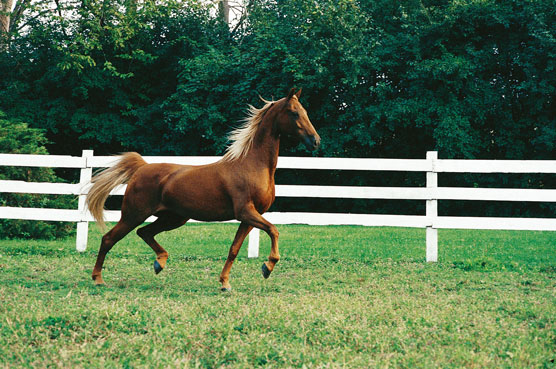
Saddlebred
Photo by: Gemma Giannini
The American Saddlebred horse was developed in Kentucky in the early part of America’s history, using Morgans, Canadian horses, Narragansett Pacers (now extinct), and horses of Spanish breeding. The goal of the people who created the Saddlebred breed was to develop a horse that could comfortably carry riders across Eastern terrain.
The Saddlebred is a gaited horse, capable of performing a four-beat gait called a rack and a stepping pace in which the legs on each side move nearly in unison with each other, in addition to an animated walk, trot, and canter. Saddlebreds with these two extra gaits are called five-gaited Saddlebreds; they’re used in the show ring. Not all Saddlebreds are born with the ability to move at the rack-and-stepping pace. The ones that move only in the breed’s high-stepping walk, trot, and canter are referred to as three-gaited. Five-gaited Saddlebreds, while bred to have the ability to do the rack and stepping pace, have been trained to perform these gaits.
Saddlebreds typically have long, arched necks and fine heads that they carry rather high. The Saddlebred’s body is lithe and lean, almost like that of a human ballet dancer. Saddlebreds range in height from 15 hands to 17 hands high. The most common colors for this breed are bay, black, brown, chestnut, sorrel, and gray. Known for having spirited, but willing temperaments, Saddlebreds are easily trained, according to the people who ride them.
In the breed show ring, Saddlebreds are exhibited as either five-gaited or three-gaited and usually in saddle seat. Driving classes also are popular for this breed. Despite their innate penchant for being flashy, Saddlebreds also make good pleasure horses and are shown even in open-breed events like dressage and gymkhana.
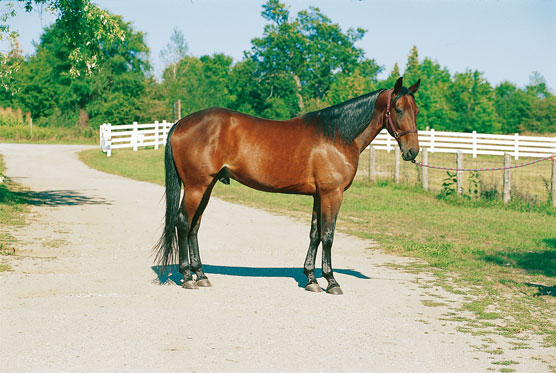
Standardbred
Photo by: CliX Photography
If you’ve ever seen harness racing, then you’ve seen a Standardbred horse. Standardbreds originated during the early part of American history and were created specifically to race under harness at either the trot or the pace.
Standardbreds have an inborn ability to move at great speeds without galloping. Some members of the breed are natural born trotters and can trot at nearly 30 miles per hour. Others are bred and trained as pacers (where the legs on one side move in unison) and can attain the same speeds. The early training of prospective Standardbred racehorses fine-tunes these innate skills while discouraging the urge to gallop. However, Standardbreds are physically capable of galloping, as is evidenced by the many Standardbred pleasure horses that do so every day.
標準種馬與純種馬密切相關,儘管標準種馬肌肉發達得多。Standardbreds 有相當大的頭和強大的腿。它們通常有 15 到 16 隻手,有海灣、栗色、棕色、灰色和黑色。Standardbred 的性格通常是溫和和可訓練的。
雖然大多數標準馬用於馬俱比賽,但許多退役的賽馬被用作展示馬和娛樂坐騎。您可以看到他們參加各種不同的比賽,包括西方課程甚至盛裝舞步。
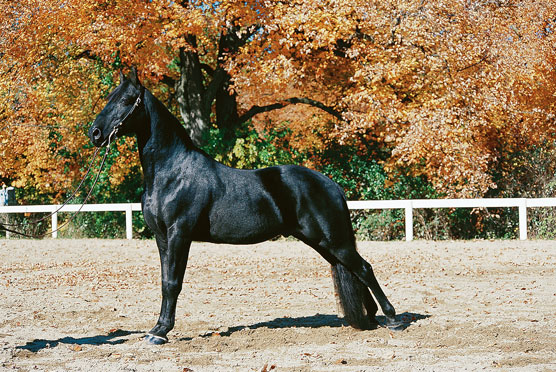
1
田納西步行馬
攝影:Gemma Giannini
18 世紀早期,一組美國品種被用來製造田納西步行馬。南部種植園主需要一個能夠覆蓋相當多的地面並舒適地覆蓋的坐騎。早期的田納西步行馬在田間工作,長途跋涉,並在周末拉著家庭旅行車。
田納西步行馬是一種步態馬,除了著名的四拍跑步步行外,還可以進行步行、小跑和慢跑。一匹步態良好的田納西步行馬給騎手一種漂浮在空中的印象。
田納西步行馬的頭直,耳朵比平常大。該品種有一個優雅的拱形脖子,突出的馬肩隆(或前肩)和大蹄。它們幾乎有任何馬的顏色。田納西步行馬的高度從 15 到 16 手不等,性格上往往是隨和的。
以田納西步行馬為特色的節目強調該品種的步態方面。然而,在許多品種一起競爭的公開表演中,您會在各種不同的活動中找到田納西步行馬。許多田納西步行馬也被用作小道馬。
1
田納西步行馬
攝影:Gemma Giannini
18 世紀早期,一組美國品種被用來製造田納西步行馬。南部種植園主需要一個能夠覆蓋相當多的地面並舒適地覆蓋的坐騎。早期的田納西步行馬在田間工作,長途跋涉,並在周末拉著家庭旅行車。
田納西步行馬是一種步態馬,除了著名的四拍跑步步行外,還可以進行步行、小跑和慢跑。一匹步態良好的田納西步行馬給騎手一種漂浮在空中的印象。
田納西步行馬的頭直,耳朵比平常大。該品種有一個優雅的拱形脖子,突出的馬肩隆(或前肩)和大蹄。它們幾乎有任何馬的顏色。田納西步行馬的高度從 15 到 16 手不等,性格上往往是隨和的。
以田納西步行馬為特色的節目強調該品種的步態方面。然而,在許多品種一起競爭的公開表演中,您會在各種不同的活動中找到田納西步行馬。許多田納西步行馬也被用作小道馬。
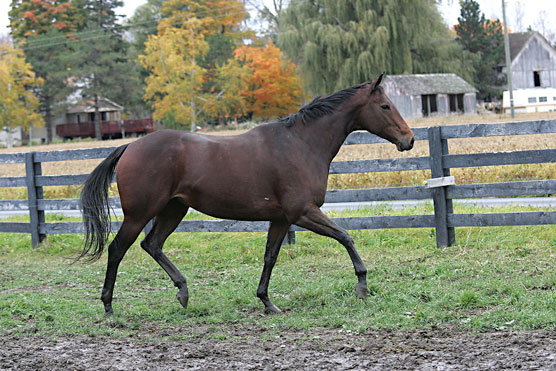
1
純種
攝影:Sharon P. Fibelkorn
純種馬於 1700 年代在英格蘭開發,嚴格用於比賽目的。該品種後來被進口到美國殖民地,在那裡它最終影響了其他品種,如標準種馬和夸特馬。
純種馬是世界上跑得最快的馬,在賽道上可以達到每小時 40 英里的速度。但賽車並不是他們唯一的才能。您通常會在表演圈中看到純種馬,在那裡他們會製作出色的跳線和盛裝舞步坐騎。
典型的純種馬頭直,馬肩隆高,腿又長又細。純種馬高 15 到 17 隻手,具有瘦長的外觀,使它們與其他品種區別開來。您在這個品種中最常看到的顏色是月桂色、栗色、黑色、棕色和灰色。
雖然純種馬是自願的馬,但它們的性情可能有些複雜,這意味著有些人可能很難弄清楚它們。由於純種馬的個性,新手騎手有時會遇到麻煩。
您最常在馬厩和後院牧場看到的純種馬是專門為表演界飼養的退役賽馬和馬匹。狩獵席位比賽中出現的大多數馬都是純種馬,儘管該品種在其他英國賽事中也表現出色,例如盛裝舞步、三天三項賽和馬術障礙賽。
深入了解約克夏犬AKC官方品種標準,包括體型、毛色、外表特徵和展示要求。專業解析幫助您全面認識這個可愛的玩具犬品種。
詳細介紹狗的解剖結構,包括鼻子、耳朵、眼睛等部位。了解狗的身體結構和特徵,提升您對犬科動物的認識。
臘腸犬適合您嗎?在您選擇臘腸犬之前,請考慮擁有臘腸犬的優缺點,以便做出明智的決策。
掌握選擇健康雪貂的技巧,並學習如何為寵物保姆提供重要信息,以確保雪貂在您的缺席期間得到最佳照顧。
學會如何修剪玄鳳鸚鵡的翅膀羽毛,根據安全需要調整飛行能力。
在訓練您的小狗時,考慮適合個性、體型和年齡的方向和解決問題的技巧,旨在建立小狗對您及其周圍世界的信心。
查看這些馬匹來源中的每一個——從個人賣家到飼養員再到野馬收養——當您嘗試尋找和購買適合您的馬匹時。
根據您的傑克羅素梗的戶外活動,您應該每月或更短時間給他洗澡,並定期護理以保護他的皮膚和毛髮。
探索非運動犬品種的特徵與健康問題,幫助您了解這些迷人的伴侶犬。
了解馬生活的世界——它們如何通過感官感知周圍的世界——以了解並妥善照顧您的馬。
